Halloween is an Urbanist Holiday (shhh don’t tell anybody)
Halloween as a Holiday – more than any other – is about neighbourhood. It is a holiday that teaches and surpasses what it means to be part of a community. I have a strong connection to this holiday, and as an adult still dress up in costume to both enjoy the night with my neighbours and to hand out candy to children and compliment their costumed efforts to keep that neighbourly tradition alive. However, as a planner and urban designer, this holiday taught me a great deal. As a child dragging a pillowcase full of sugar treats through the night, I learned a lot about city-building, even if I wasn’t aware at the time.
This is a holiday that survives on social capital, but is also innately reliant on the built environment. The basic premise is right in the phrase joyfully screamed at each doorway: “Trick-or-Treat!” It is a social contract that demands participation from both sides (I give more candy to those with more effort and heart in their costumes), but is also inherently connects that participation to the larger community. The act of decorating yards with jack-o-lanterns is to be explicit about participation as a “neighbour”. The young, going from door to door, are shown their connection to their community and their place with each glowing pumpkin or “scary” display, expressing connection and distinctiveness of each “home”.
Best Neighbourhoods for Trick or Treating
The tradition of Trick or Treating, as it still exists, by its nature of going from door to door is a very urban act. One thing it teaches a child (or at least this planner-to-be) is about livable density. Because my family had moved through a number of neighbourhoods when I was young, I started realizing that not all were built equally for the door-to-door quest. The desire for MORE CANDY forced into me a realization that some neighbourhoods were hard to walk through and garnered little loot, while others left me with more candy than my small arms could carry.
The main metric for success of a trick or treater, at least as Seinfeld reminisces, is to “GET CANDY”. What made these neighbourhoods different was their form.
Legends of wealthy suburban houses giving out full size candy bars, didn’t chalk up to the knowledge that I could fill a pillow case to capacity if I went through the socialized row houses and tight packed smaller houses of inner-city working class family neighbourhoods. At a young age I worked out a simple equation: More doors to the street per block = MORE CANDY= better.
At VIA Architecture, we like to back-up our poetic declarations with mathematics, so I have decided to ruin my inner child’s favorite holiday with math homework.
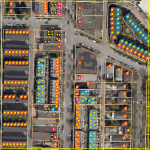
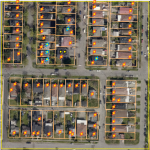
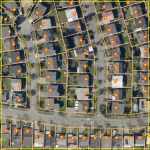
FORM
I looked at three representative neighbourhoods in Vancouver, BC (where I grew up) to calculate where a child could get the best candy haul.
The Inner-City Street Car Grid neighbourhood presents a tight grid of streets, alleys with a mix of older and Vancouver special houses.
The Suburban neighbourhood has large houses on loop and disconnected cul-de-sac streets.
The Urbanist neighbourhood shares the tight street grid with the inner-city neighbourhood, but includes a layer of pedestrian access and dense rowhouse forms that tightly pack those streets with units.
AREA
I have bounded those areas into a 200m (700ft) square. This 4 hectare (10 acre) box gives us at least a couple of blocks to examine and explore as a hypothetical trick-or-treater. As a planner it also gives us some consistency of built form.
FRONTAGES
As a trick-or-treater, any door to a street is a possibility for candy. Participation varies, but let’s suggest most houses will participate in handing out candy. For this I will assume that each house represents a piece of candy, and that some houses will give out more candy, making up for non-participants – who will have their houses rightfully egged. I have also broken down the units by frontage types:
Doors to the Street [represented below with an Orange candy]: These units have a stoop or door facing public space.
Potential Doors to The Street [represented below with a Blue Candy]: These units have access that could potentially be opened to the public, but face what is often shared or private open spaces. In the case of houses, these could also be counted for secondary dwelling units.
Retail Frontages [represented below with a Red Candy]: These sometimes participants should not be excluded from the festivities especially in mixed use neigbourhoods.
Above Grade Apartment Units [represented below with a Black Candy]: These units are often not directly accessible to the street and were not counted. These inaccessible apartments show why a direct unit-count might not be as useful of a metric, especially in terms of filling a pillow case. I have not included these in the count.
DISTANCE WALKED
In order for an accurate experience of trick-or-treating to be presented I felt it was worth showing the amount of approximate linear distance a child would have to walk to complete their bon-bon run.
I should note that I calculated this as a general distance and did not include the small movement into and out of yards for individual houses. To show this movement, sets of footprints on the diagram represents about 100m (300ft) of walking and generally how far someone would have to walk in order to knock on all the doors of the neighbourhood.
By The Numbers, What Are the Best Neighbourhoods for Trick or Treating?
Inner City Neighbourhoods
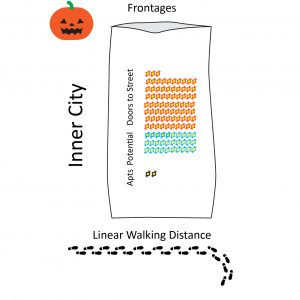
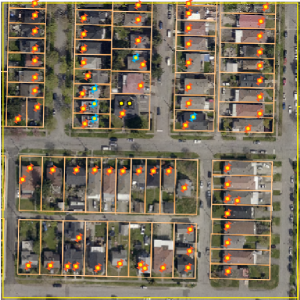
The old streetcar neighbourhood that I examined is pretty typical of Vancouver or many inner-city streetcar era neighbourhoods across North America. It has lanes, ~10 m (33 ft) wide lots, regularized streets, and many single family homes.
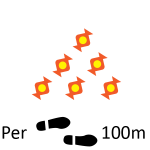 4 hectare (10 acres) of this older urbanism has the ability to present 73 doors to knock on.
4 hectare (10 acres) of this older urbanism has the ability to present 73 doors to knock on.
19 doors per hectare (8 per acre)
With 1100m (0.7mi) to walk that’s 7pieces of Candy per 100m (300ft)
With the inclusion of secondary suites (I only counted five explicit side doors, but there are likely more) and laneway suites that count could increase substantially. I easily see it filling to 30 more and filling the pillow case up beyond 100 candies and ten pieces per 100m. But that would come with official addressing and legalization of those suites.
Sub Urban Neighbourhoods
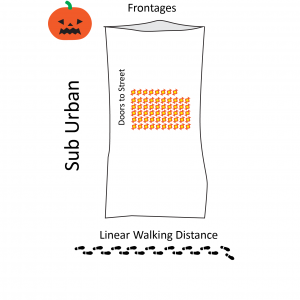
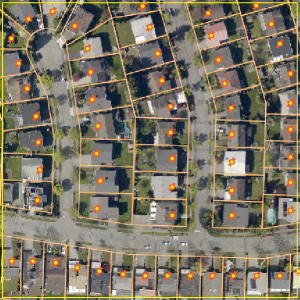
The loop and lollipop suburban neighbourhood that I looked at was in the far south-east of the City. This is not a common layout in Vancouver proper, but is very typical of most of the City’s post-war auto-oriented suburbs. It has no lanes, 15m+ (50ft+) wide lots, curvilinear and disconnected streets, and only single family homes.
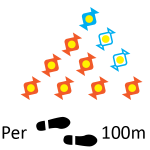 4 hectare (10 acres) of this auto-oriented form has the ability to present 58 doors on which to knock.
4 hectare (10 acres) of this auto-oriented form has the ability to present 58 doors on which to knock.
14.5 doors per hectare (6 per acre)
With ~900m (0.56mi) to walk, that’s six to seven pieces of candy per 100m (300ft)
This is a thinner pillowcase of candy. It is difficult for neighbourhoods like this to grow without changing how they are laid out, but there is potential for infill and secondary suites here. I will however note that this area in Champlain Heights is adjacent a number of housing complexes that are much denser and connected than these houses. In fact they are an older analogue to our last examined neighbourhood type.
Urbanist Neighbourhoods
This mixed-use redevelopment in the Cedar Cottage neighbourhood infills the typical urban grid of Vancouver, but adds a layer of new development and new connections. It activates all of its edges with doors directly facing the street and lanes. This is not as typical in Vancouver, but is a development type that is gaining traction in many recently re-planned areas. Many of the design lessons here are connected to the older housing complexes in False Creek South and Champlain Heights (great trick-or-treating neighbourhoods in their own right). It has lanes and a mix of lot sizes, but tight frontages and minor, to even non-existent, setbacks.
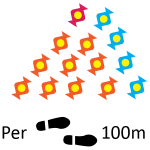 4 hectare (10 acres) of this pedestrian- and transit-oriented form has the ability to present 121 doors facing the street on which to knock.
4 hectare (10 acres) of this pedestrian- and transit-oriented form has the ability to present 121 doors facing the street on which to knock.
30 doors per hectare (12 per acre)
With 1400m (1.1mi) to walk, that’s 8.5 pieces of Candy per 100m (300ft)
With the inclusion of the second layer of rowhouses and retail frontages the number of potential candy doors increases to 195. That is 14 pieces of candy per 100m (300ft). I will also note that this neighbourhood is only a little more than halfway through its redevelopment and that future potential is not counted in this analysis.
WINNER: This is the most overflowing bag of candy.
(AUTHOR’S NOTE: Parents from other neighbourhoods, please don’t take advantage of these nice people.)
Jack-o-Lanterns on the Street
Anecdotally, I have found that the densities of frontages also mean that more people participate in making front door displays and giving out candy. It becomes part of a localized culture. Intrinsically, I knew other things about these neighbourhoods as well: they are more likely to have more movement choices and access to transit and they were more likely to have a mix of uses, including some retailers that would give out treats (unfortunately less likely to be coveted chocolate). I am observing that retailers have an increasing role in this holiday, and now indoor malls often have day-time trick-or-treating events as well. In many suburban areas these malls may be the strongest concentration of doors that children will know… but I still feel it pales to true night time trick-or-treating.
I also want to note that I am not including the apartments in these calculations as they are inaccessible to the candy searchers on the street. If these neighbourhoods were made of apartments with lobbies, such as those commonly built in many core neighbourhoods in the 1930s through 1970s, the number here could drop to as low as 25 doors accessible to the street. In this way, the densest neighbourhoods could by far provide the lowest number of treats (one to two candies per 100m of effort) for local children.
I have found, as a planner, that this jack-o-lantern metric holds up as a definer of u rban livability. It is a function of density, but it is also about neighbourhood connection and activation. If a neighbourhood has more units with more connection to its streets, the likelihood of those streets being part of a child’s territory is also increased. These are generally healthier neighbourhoods with active opportunities for interaction and social capital-building. They are healthier, save for the increased risk of cavities carried in their heavier pillowcases and treat buckets every October 31st.

Happy Halloween.
Doors to the Street Make for a stronger Trick-or-Treat.
Brendan Hurley is a Planner and Urban Designer at VIA Architecture in Vancouver. He will be dressed as a dimension hopping mad scientist this year.


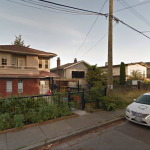
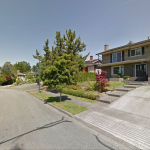

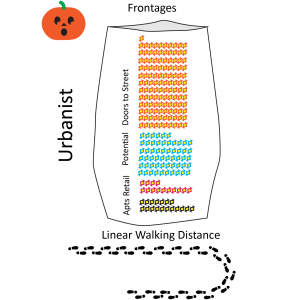
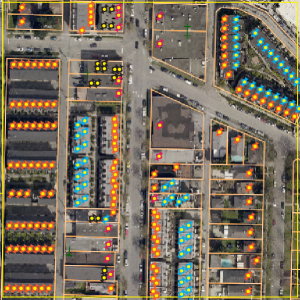
2 comments
I think it’s a mistake not to include the distance from the sidewalk to the door. It represents a large portion of the total distance walked, particularly in the suburbs. A lot of suburban neighbourhoods (particularly wealthy ones from the 1960s) have absurdly large front yards that trick-or-treaters have to cross, as compared to the shallower yards of streetcar neighbourhoods or the even shallower depths of the setbacks in front of urbanist row houses.
Ben, I completely agree, which is why that was noted. I made a call on how much resources (production time) and accuracy I was measuring for. If I update this article, I will definitely include the representative door-to-door distance. Similarly I would love to add a set for an apartment neighbourhood, and a set of strategies to include those households to the Halloween spirit, because y’know… the more the merrier.